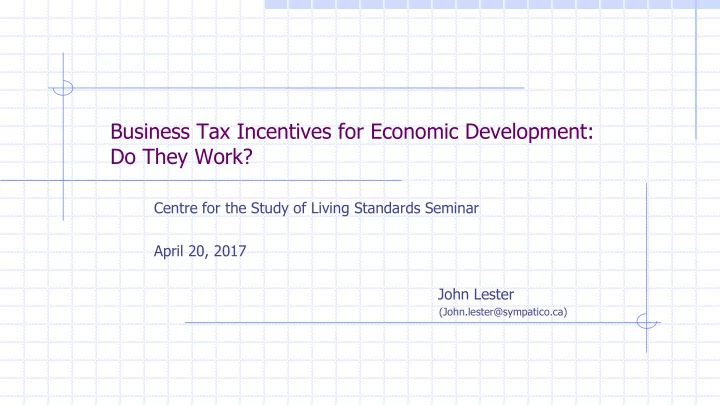

Business Tax Incentives for Economic Development: Do They Work? Centre for the Study of Living Standards Seminar April 20, 2017 John Lester (John.lester@sympatico.ca)
Business Subsidies in Canada 2014-15 Total Business Subsidies: $33.5 Billion Distribution by Instrument [CATEGORY NAME] [PERCENTAGE] GBEs 14% Tax incentives -- Corporate 43% $16.5 $17.0 Spending programs 29% Tax incentives -- Other Federal Provincial 12%
Federal and Provincial Business Tax Incentives for Economic Development 2015 Cost ($ million) Federal Provincial Total Low tax rate for small businesses 3,250 5,500 8,750 Non-refundable SR&ED investment tax credit 1,360 335 1,695 Apprenticeship Job Creation Tax Credit 95 - 95 Atlantic Investment Tax Credit 230 230 Deductibilty of cross border interest expense 2,500 1,880 4,380 Accelerated depreciation for M&E used in manufacturing 320 250 570 Accelerated deductibility of some exploration expenses n.a. n.a. n.a. Accelerated depreciation for vessels n.a. n.a. n.a. Low rate for M&P -- SK, ON, QC (SMEs only), NL. 268 268 Investment Tax Credits for M&P -- SK, MB, QC, PEI, NS. 183 183 Tax Holidays -- QC, PEI, NL. 27 27 Tax credit for international financial centres - QC, BC 24 24 Additional CCA for vessels - QC n.a. n.a. Total 7,755 8,466 16,221
Rationales for business subsidies Mitigate market failures Industrial policy Optimal tax policy 4
Framework for Benefit-Cost Analysis National Measures Impacts of a targeted tax reduction Benefit: Additional investment + MEB CIT Spillovers 0 / + Resource allocation effects - / + Sectoral variation in UC elasticity 0 / + Tax base shifting 0 / - Relative cost-effectiveness 0 / + Impact of a general tax rate increase Cost: Less investment - MEB CIT
Benefit-Cost Analysis of the Small Business Deduction (cents per $ of tax revenue forgone) Efficiency cost of taxation -- All firms 41.0 Adjustment for tax base shifting -5.4 Adjustment for lower productivity -2.7 Efficiency cost of taxation -- small business 32.8 Social Benefits Mitigate capital market failure 0.6 Tax reduction for small business 32.8 Subtotal -- Benefits 33.4 Social Costs Tax increase for large businesses -42.2 Net social benefit -8.8 Other costs not quantified Increased tax evasion - Higher administration and compliance - Threshold effects on investment -
Benefit-Cost Analysis of Cross-border Interest Deductibility (2015, cents per $ of tax revenue forgone) Efficiency cost of taxation All firms 41.0 MNEs without tax base shifting 35.6 Benefits Induced effects on domestic investment 1 15.1 Repatriated after-tax income -0.1 Increased productivity of MNE's domestic assets 1.4 Productivity spillovers on non-MNEs 0.5 0.7 Higher productivity of MNEs 17.6 Subtotal Costs Substitution between domestic & foreign assets -1.7 Efficiency loss from a general rate increase -41.0 Net social benefit -25.2
Benefits and Costs of Accelerated CCA for Selected M&E Assets used in Manufacturing (Cents per $ of Tax Revenue Forgone) Efficiency cost of taxation 41.0 Adjustment for international tax base shifting -5.4 Adjustment for higher relative cost-effectiveness 24.4 Efficiency gain from the selective tax reduction 60.1 Resource allocation effects Inter-asset -- within M&E -2.1 Inter-Asset -- M&E vs. other assets -1.6 Inter-industry -0.9 Efficiency loss from a general tax rate increase -41.0 Net social benefit 14.4 Non-quantified impacts Higher administration and compliance costs - Premature retirement of capital - Spillovers +
Benefit-Cost Analysis of Provincial Tax Incentives for Manufacturing and Processing in a Competitive Equilibrium -- Parameters Statutory Rate Investment Tax Reduction Credit Efficiency cost of taxation (cents per $ raised) 41.0 41.0 Adjusted for international tax base shifting -- 35.6 Adjusted for relative cost effectiveness 0.0 60.1 Adjusted for higher prov. investment elasticities (25%) 51.2 74.1 Weighted rate change 1.7% 5.7% Reduction in the user cost of capital 0.2% 5.7% Provincial tax base semi-elasticity 2.2 Input elasticity of substitution 2 2
Benefits and Costs of Provincial Tax Incentives for Manufacturing Evaluated from a Provincial and National Perspective (Cents per dollar of tax revenue forgone) Rate Reduction ITC Provincial National Provincial National Impact of selective tax reduction Efficiency gain from increased investment 51.2 41.0 74.1 60.1 Resource allocation effects Provincial inter-industry -0.0 -0.0 -1.6 -1.6 -- 1 -- 1 Inter-Provincial -0.0 -1.8 Inter-asset (Short vs. Long-lived) -- -- -1.7 -3.7 Tax base shifting within province -3.0 -3.0 0.0 0.0 Tax base shifting -- interprovincial 3.4 0.0 0.0 0.0 Subtotal 51.6 38.0 70.8 53.0 Impact of general rate increase Efficiency cost of decline in investment -51.2 -41.0 -51.2 -41.0 -- 1 -- 1 Interprovincial resource misallocation -0.1 -3.3 Inter-provincial tax base shifting -6.4 0.0 -6.4 0.0 Subtotal -57.6 -41.1 -57.6 -44.3 Net social benefit -6.0 -3.1 13.1 8.7 Non-quantified impacts Premature retirement of capital NA - Additional admin and compliance costs - - Higher TFP in manufacturing + + Higher user cost sensitivity in manufacturing + + 1. Included in efficiency benefit/cost of taxation.
Business Tax Incentives for Economic Development: Do They Work? Summary Small number of measures with a high fiscal cost. Intervention is successful only for the large firm SR&ED credit and other targeted investment tax credits. The social cost of cross-border interest deductibility is particularly high. The necessary conditions for a successful industrial policy appear to exist. Scope for applying optimal tax principles. The case against investment tax credits is weaker than I expected.
Recommend
More recommend